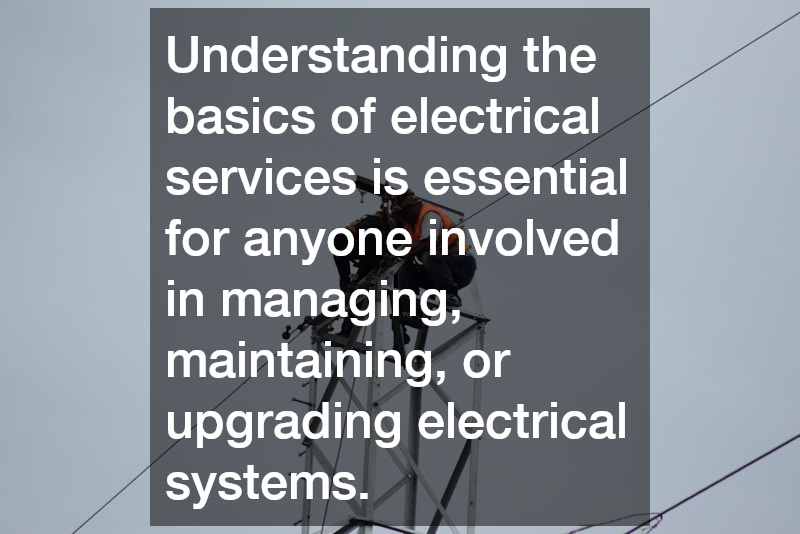In this article, we will explore the fundamentals of electrical services, a critical component of modern infrastructure. Understanding electrical services helps to ensure safety, efficiency, and reliability in residential, commercial, and industrial settings. This guide will address some of the most common queries related to electrical services to provide clarity and insight for homeowners, business owners, and aspiring electricians.
What Are Electrical Services?
Definition and Components
Electrical services refer to the provision of electricity from the main power grid to the end-users’ location, encompassing equipment and systems such as service panels, circuit breakers, and wiring. These services form the backbone of modern living, enabling everyday activities from lighting homes to powering industrial machinery. The components of electrical services, including wiring, switches, and outlets, are designed to safely deliver electricity with precision. Each component plays a unique role in the seamless transfer of power, ensuring that end-users receive the necessary energy to run devices and appliances. Understanding these components is crucial for anyone involved in the installation or maintenance of electrical systems. Knowledge of how each part functions can improve both safety and efficiency in its use.
Types of Electrical Services
The two primary types of electrical services are residential and commercial/industrial, each with specific requirements and standards for voltage and capacity. Residential electrical services typically operate at lower voltages and are designed to meet the demands of households. In contrast, commercial and industrial services cater to larger, more energy-intensive operations, requiring robust systems to handle higher capacities. Commercial installations often include complex systems like three-phase power and advanced load management. Understanding the differences between these types is essential for designing systems that efficiently meet the specific needs of each setting. Both types of services must comply with strict regulations to ensure safety and functionality.
How Does an Electrical Service Panel Work?
Purpose and Functionality
Also known as a breaker box, an electrical service panel controls the distribution of electricity within a building and provides overcurrent protection via circuit breakers or fuses. This system acts as the central hub for electricity, directing power where it’s needed and preventing overloads that could lead to safety hazards. By cutting off power during a surge, circuit breakers protect both the electrical system and the end users. Regular maintenance and inspection of the panel are vital to ensure long-term reliability and safety. Understanding its purpose and functionality can help identify issues before they become serious problems. The effective functioning of the service panel is a testament to the sophistication and reliability of modern electrical systems.
Components of an Electrical Service Panel
An electrical service panel comprises various components, including the main breaker, circuit breakers, and bus bars, each playing a critical role in electrical distribution and safety. The main breaker serves as the control point for the entire panel, allowing power to be cut off when necessary. Circuit breakers distribute power to various circuits and protect against overcurrent. Bus bars function as the central node of the panel, conducting electricity to the breakers. Together, these components create a balanced and controlled environment for electricity distribution. Understanding these components is essential for troubleshooting and upgrading electrical systems. Regular inspection can prevent potential faults and enhance system longevity.
What Are the Safety Measures for Electrical Services?
General Safety Guidelines
Safety measures such as the use of personal protective equipment (PPE), adherence to codes and regulations, and regular maintenance minimize the risk of electrical hazards. The most effective way to maintain safety is by ensuring all personnel interacting with electrical systems are adequately trained and aware of potential risks. Adhering to national and local electrical codes is essential to ensure installations meet safety standards. Regular maintenance and inspections help identify issues that can lead to dangerous conditions, such as faulty wiring or overloaded circuits. Using PPE, such as insulated gloves and goggles, can protect against accidental contact with live components. Together, these guidelines promote a safer work and living environment.
Dealing with Electrical Faults
In the event of electrical faults, prompt identification and response, including isolating power and contacting a qualified electrician, are crucial to ensuring safety. Immediate action can prevent further damage and reduce the risk of injury from electrical fires or shocks. Troubleshooting electrical faults often involves assessing visible symptoms, such as tripped breakers or flickering lights. It’s important to avoid attempting repairs without proper knowledge or equipment, as this can exacerbate the issue. Calling a qualified electrician ensures that faults are diagnosed and resolved correctly. A comprehensive understanding and quick response to electrical faults can prevent serious incidents.
Understanding the basics of electrical services is essential for anyone involved in managing, maintaining, or upgrading electrical systems. By addressing common questions and concerns, this article aims to provide foundational knowledge that enhances safety and efficiency in interactions with electrical services. As electrical infrastructure continues to evolve, staying informed about the latest practices and technologies is key to maximizing the benefits of electrical systems. This includes ongoing education and awareness of safety standards and regulations. An informed approach facilitates a safer and more productive environment, whether at home, in a business, or at an industrial facility. This knowledge empowers stakeholders to make informed decisions about their electrical needs.

